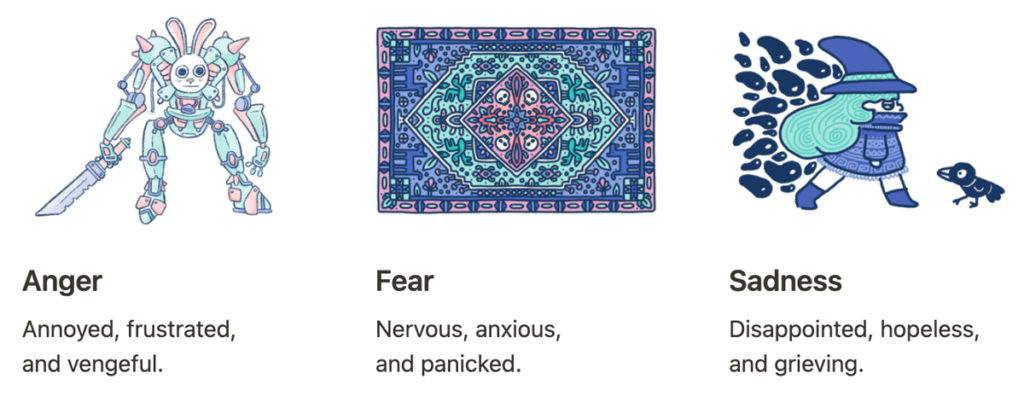NOTE: This is Part 1 of a 5-part series. Read more with Part 1 (intro), Part 2 (anger), Part 3 (fear), Part 4 (sadness), or Part 5 (hope).

So uh… January was kinda tough, eh? And 2021 was kinda rough, yeah? There’s a lot going on right now, both globally for everyone and personally for each of us. I don’t know about you, but I’ve been bouncing around from emotion to emotion, building up the blobbies in my brain.
But thankfully, I’ve settled down enough to get back into drawing and am able to utilize artmaking as an important coping skill again.
I’ve always used drawing as a form of art therapy, even before I realized I was doing it. Now that I’m aware of how vital drawing is to my mental health and wellbeing, I think it’s high time I dig deeper into the process and make it a more concrete practice for myself and others who may be interested. (Hey, my word of the year is already helping me make decisions!)
So this week, I’m starting an essay series about making art to process our emotions. I plan to make this into a Skillshare class series as well, but will be exploring and writing about it here first.

Drawing Emotions to Experience Them
Emotions are confusing and if we’re not aware of them, they can easily take over and start steering the ship. We often try to ignore or repress our emotions but it never really works—the emotions are still there. And then, when we fail to get rid of the emotion, we now have new secondary emotions, like guilt or shame, added on top of whatever we initially tried to ignore! It’s a mess.
Through years of depression, therapy, reading, and studying, I’ve finally realized and accepted the notion that the only way to manage our emotions is to feel them.
“If one actually feels the living quality, the texture of the emotions as they are in their naked state… automatically one begins to see the simultaneously ironical and profound aspect of the emotions as they are. Then the process of transmutation, that is, transmuting the emotions into wisdom, takes place automatically. The problem is that we never experience emotions properly.” –Chögyam Trungpa, Tibetan Buddhist
But how do we actually do that? How do we allow ourselves to feel and experience our emotions? A Buddhist might tell you to meditate. A therapist might tell you to talk to someone. A runner might tell you to run.

Those things are all good and helpful, but I’m an artist. For me, drawing is the most helpful way to see, feel, and process my emotions. Amazingly, and different from those other recommendations, drawing allows me to experience my abstract, ambiguous feelings in a concrete, tangible way.
When I begin drawing, I often have no idea how I am feeling. But as I draw, whatever emotions I’m feeling subconsciously slip out onto the page. They become visible. Seeing the emotion right there in front of my eyes allows me to move from a state of unconscious feeling into a conscious state of understanding. And as Trungpa said, it’s much easier to see the wisdom of our emotions once we’ve actually experienced it. We can then begin to unpack our feelings and learn how to manage them.

The Power of Drawing
Making art is the surest path to connecting to my inner thoughts and listening to what my emotions are trying to tell me. And that’s important because our emotions are there for a reason. They’re always trying to tell us something.
The Harvard psychologist Susan David says,
“Emotions signal rewards and dangers. They point us in the direction of our hurt… They can be beacons, not barriers, helping us identify what we most care about and motivating us to make positive changes.”
If we’re unable to see and listen to our emotions, we’re flying blind. We’re disconnected from the inner part of us and from others around us as well. We’re more likley to lash out, withdraw, or shut down. But by recognizing how we’re feeling through drawing, we are can become more self-aware and make meaning (and art!) from our hurt.

When we’re in the midst of intense emotion—be it anger, sadness, or grief—it’s incredibly difficult to understand what’s going on in our minds and share that experience with others. We often don’t even realize that we’re angry, sad, or grieving. So how could we possibly reach out to others for help and connection or begin to heal if we aren’t even aware of how we actually feel? How could put words to an unknown feeling?
Drawing gives us the power to communicate first with ourselves. The act of drawing gives a voice to our inner thoughts and forces us to remain open, still, and quiet enough to listen to it. And once we’ve heard what it has to say, we’re more able to communicate and connect with others about how we’re truly feeling.
There will always be periods in our life of struggle and pain. It’s just a part of being human. But instead of trying to ignore the pain or get rid of it, we can make art to see our pain, listen to it, and learn from it.

Where We’re Going
In this series, I aim to show you how I use the process of drawing to make sense of what we experience as humans. I’m very excited to dig into this, and have already done much of the initial leg work.
The psychologist Paul Ekman theorizes there are six basic emotions: anger, disgust, fear, happiness, sadness, and surprise. For this series, I will be focusing on Anger, Fear, and Sadness, with one essay per emotion. Each essay will include some basic research on the emotion, as well as a real-life example of a time I felt that way and took to my sketchbook. Over the years I’ve subconsciously developed a few emotional-drawing go-to’s and I’ll now be analyzing more closely how and why drawing in these four different ways helps me experience and process these four different emotions.

Once I’ve completed this series of essays, I’ll be compiling it all into a Skillshare class, where the drawing example will be further expanded into a project assignment that students can complete and share in the class gallery.
Drawing is one of the most powerful tools in my mental health toolbox. It helps me move from a place of confusion, helplessness, and hopelessness, into a place of clarity, empowerment, and optimism. It shows me that emotions are just emotions and I am fully capable of experiencing and managing them.
Drawing reminds me that I can take something difficult and painful and make meaning and art from it, and I hope that through this series, maybe drawing can help you do that too.
Thanks for reading!
<3,
Christine
Read more with Part 2 (anger), Part 3 (fear), or Part 4 (sadness).

